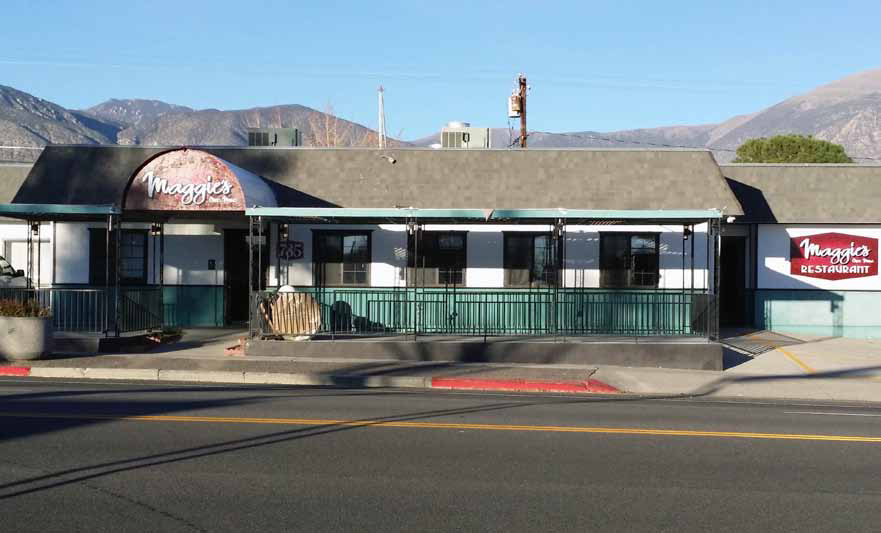Sheri Samson
State Park Ranger Aide Larry Spickert chats with visitors at Nine-Mile Ranch.
“I was wondering when one of you would be getting up here to talk,” said State Park Ranger Aide Larry Spickert. With only one year under his belt as the acting caretaker of the Nine-Mile Ranch and historic stage stop, Spickert easily rattled off a short history lesson using the valley’s richest stories.
“I am the eyes and the ears of this place for now and since June 28, 2017,” he explained. Beginning as a “volunteer conservancy protector” to prevent vandalism on the damaged property while it was in disarray and unsafe for trespassers, he camped out while overseeing the premises. He began greeting those that stopped for pictures and answered questions about the inhabitable dwelling which was drastically hit by the Dec. 28, 2017 earthquake. “The epicenter was right over in that field where the horses are standing,” Spickert shared while pointing east from the crumbled brick debris which remained on the old home’s property.
Known to be the oldest standing building left in Mineral County the homestead began as Utah territory in the 1860’s, known as the Cobb’s Ranch. Only one historic notation on a map documented this, with no evidence left on the property.
“Then the Gardener family took ownership, back when Aurora was busy with miners digging for gold and Mark Twain mentioned in his writing that “John Nye is sick, so I am going to help nine miles from Aurora” – which is possibly how it became the Nine-Mile Ranch.” Spickert explained that stage stops were known as mile houses. It was a place to water horses, trade out horses and accommodate people coming through.
According to archivists, Esmeralda County was founded in 1861, with Aurora as the county seat until 1883, which made the Nine-Mile Ranch a thriving destination with workers being hired to harvest alfalfa and various other seasonal crops.
“See that root cellar? (A building sitting separately from the main house.) It sustained some light damage in the earthquake but it’s one of the older structures. Being built into the hillside saved it, unlike the main house which seems to be held up by the front porch, added on in later years. It’s keeping the building stable for now.”
Spickert went on to explain that it was Amos Green who built the historic stone house on the property he purchased in 1870. Originally a logger, then owning a saw mill in the Bridgeport area, he was a businessman with a vision. Research shows that Green brought in the sandstone blocks from a local quarry around Rough Creek, about 22 miles from Hawthorne. Green’s burial site remains, off to the side of his rustic home, with a rock headstone among the fenced-off family plots. It clearly reads 1806-1890, showing he lived a long life for men within that era of time.
“This was also a toll road, as the elbow stop from Aurora to Carson City. They even had a pay station along this roadside.”
Green’s daughters eventually married the Fallons and Spickert shared that even today those ancestors stop by to visit. Much later the property was purchased by a philanthropist named Fleishman who put an air strip behind the home and updated the structure, making the property a premier ranch throughout the 30’s and 40’s.
Today, even as Spickert sacrifices his own comfort without electricity, he points out to the aging barn and fencing, giving heed to the leased land which remains a working ranch. “I respect this place and the state wants to restore it.”
Although he is now a paid state employee, Spickert is no stranger to volunteering. He has been a seasonal coach, assisting baseball teams, working with high school students and part of the Sportsman Club.
As a kid raised in Hawthorne, he shared a story of his mother’s friend, Alice Tuttle, who lived in Fletcher. “We would come out this way to visit her and then go exploring all around here, catching frogs. I guess this valley has been part of me for a long time.”



There are power lines leading all the way from H-Town to the ranch house…why is there no power ?
The State of Nevada can’t furnish this guy with a generator ? Better yet, why don’t they just turn the power back on . That ranch house had electricity before the earthquake, and the power lines are still there …